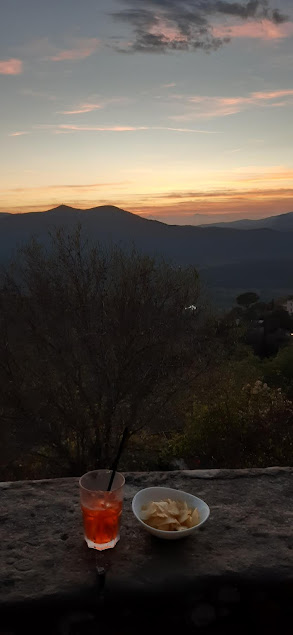On the third day of our weekend getaway in the Maremma, my friends opted to skip the beach and instead visit the town of Massa Marittima on our way back to Florence. I had not been to this town, and truth be told, had not heard of it. Sergio mentioned that I would get to see the famous fresco of a "cock tree". I wasn't sure how to imagine this fresco, and Sergio just said to wait and see. I was intrigued.
Shortly after we left the B and B, we turned off onto a dirt road. "Where does this lead?" I asked? The reply, "To the house up ahead." Our first stop was at a farm to buy some of their favorite jarred veggies and sauces. First we chatted. Then, we selected vegetables that were picked that morning-- pomodorini, lettuce, zucchini blossoms, an assortment of peppers. We crossed the lot from the farm area into the shop where there are cupboards of jarred vegetables. A specialty of this shop is the artichokes. After a comprehensive selection, payment and more conversation, we were on our way.
Since we were still in the hills of Tuscany, the drive was beautiful. We reached the municipal parking lot of Massa Marittima in time to get one of the last spots. It was Sunday, good weather, and a mountain bike race ending in the town! Our first stop was the fresco.
Try to look closely and see the "unusual fruit" hanging from the tree and that the women are collecting. The fresco is located behind a trough where women would go to wash clothes. It was hidden behind a plaster wall and discovered in 1999!! The fresco is dated between 1265 and 1335 and referred to as the "Tree of Fertility". It might also have been symbolic for an abundant harvest.
The area of the town dates back to prehistoric times. There were Etruscan settlements nearby. It was caught between the wars of Siena and Florence. In more recent history, Massa Marittima was an important site for the mining of minerals such as iron, mercury and copper. The last mines closed in 1994, and now its main income is tourism. And, apparently, mountain biking.
The construction on this cathedral dates to the 1200's. It is dedicated to San Cerbone, Saint Cerbonius, who had a long and unusual life. His story is told in bas relief around his tomb inside the church and also above the door on the outside of the cathedral.
https://en.wikipedia.org/wiki/Cerbonius
https://www.turismomassamarittima.it/en/la-cattedrale-di-san-cerbone/
The day we visited Massa Marittima, was also the day of a mountain bike race. For me, this was quite special as it brought back memories of the many times I accompanied my son to various mountain bike races and courses, especially before he could drive. In this piazza, the contrast of the young riders and the ancient buildings was notable.
The day was wonderful and filled with the joy of being in Italy-- good friends, surprising art, ancient history, great food, and the sign of new life in old surroundings.
Be sure to add Massa Marittima to your travel list for Tuscany! Ciao for now!



















